Ben Crenshaw: “There’s not much strategy left at Augusta”
Published: Last updated:
A two-time Masters champion, Ben Crenshaw’s majors haul might have been more had it not been for a misfiring 2-iron. Here, in conversation with John Huggan, he looks back on near misses, lessons learned, his knowledge of Augusta National, and a nickname he doesn’t deserve.
As far as my playing career is concerned, I am happily retired, Ben Crenshaw says. I’m happy just building a few courses here and there with my design partner, Bill Coore. We’ve been together more than 30 years now. We only do one or two at a time, which is a nice pace. What really gets us interested is the quality of the land. We like to work with what we are given and do little things to it. If the client has a piece of property that requires a lot of construction, we tell them that there are a lot of wonderful people in our business who can do the job they want a lot better than we can.
Our philosophy is simple, when it comes to building courses. The more earth you have to move, the more difficult it is to make the end result look natural. We’re a bit old-fashioned in that way. Both Bill and I are traditionalists. Which is good in golf. The game has so many great things that have lasted a long time. And those things have a hard time dying out. Most of the things we love about courses stem from what you in the United Kingdom gave us more than 100 years ago. We just follow that lead.

I have two majors titles to my name, the 1984 and 1995 Masters. But I came close in a few of the others. The loss that was really self-inflicted was the 1975 US Open at Medinah. I had the lead but hit my 2-iron tee shot at the short 17th into the water in the last round. It was a bad shot. I hit it off the toe and the ball didn’t make the carry. I made a double-bogey and missed the play-off by a shot.
THE MASTERS: 2008 champion Trevor Immelman on beating Tiger and his injury heartbreak
I had a couple of near things in The Open, too. When Seve Ballesteros won at Royal Lytham in 1979, I made another double-bogey at the 71st hole. The 2-iron was again the culprit. I tugged my second shot into the bunker and made a six. But Seve was going to win that one anyway. He played so many great shots that day, especially when you consider where he hit some of his drives. But he produced the goods when it mattered. My whole career I really wanted to win The Open. I was a distant third at Muirfield in 1980 when Tom Watson won. That wasn’t really a chance. But I had a few over the years.
I lost a play-off for the PGA Championship in 1979 to David Graham. But I had no business getting that close. David made a double-bogey on the 72nd hole to tie me. Having said that, I could and maybe should have won at each of the first two holes of the play-off. But it didn’t work out.

My first visit to The Open was in 1974 at Lytham. Gary Player won. I had to qualify at St Anne’s Old Links. That was where I met my long-time caddie over there, Bobby Millen from Glasgow. We were introduced by another Glaswegian caddie, Willie Hilton, who caddied for Tony Jacklin at the time. Bobby and I had a long association. It took a while for me to understand what he was saying, but I got there eventually. We had a life-long friendship.
I always loved links golf. That stemmed from me growing up in Texas. Conditions there are often hard and fast, which is a lot like golf by the seaside. We maybe couldn’t run the ball in quite as much as you can in Scotland, but I could see the shots I needed to hit and enjoyed the challenge. I loved it. All of it. I still regret that I didn’t go to The Open in either 1975 or 1976. I was back at Turnberry in ’77 though.
The Old Course has always captivated me. It always will. I love Turnberry, too. And I am a big admirer of Royal St George’s. I love the green complexes. They have great shape to them, as do the bunkers. I watched my friend Bill Rogers win there in 1981. But Birkdale might be my favorite in England. It’s a beautiful test, one that requires all the shots. But I like Lytham too. Hell, I like them all.
I was an architect in my head from an early age. My love of course architecture and golf history goes back to when I was 16. I played in the US Junior at the Country Club in Brookline. My head was in a book that whole week. And I’ve been studying the game and the courses ever since. I’ve been lucky of course to have been all over the world. That has allowed me to see so many great courses. I love to analyse how the architects routed each one. That is enthralling to me.
The Old Course remains the ultimate test for me. There are a million ways to play it. Like Augusta National, you can play it your whole life and never stop learning. There are ways around the Old Course like no other place in the world. It’s like playing a big crossword. Every little wind shift changes everything. And it challenges every aspect of your game without recourse to long grass. There’s no other course that makes you think harder. But you have to know it to pick your route, depending on the breeze. It is just endlessly fascinating. And totally natural.

I’m not sure I could play the way I did and be competitive on today’s tour. Forget for a moment how athletic so many of the modern players are. They are in such great shape. The golf ball does not curve as much as it used to. We could really curve the old balata ball. So it is astounding to me that Bubba Watson can hit the shots he can hit. I’m not going to say artistry has been lost in the modern pro game – that covers too much ground – but today the game at the top level is all about power.
The advances in technology are a trade-off. They have helped amateurs hit better shots and hopefully enjoy the game more. But, on the other hand, you have to consider how many billions of dollars have been spent retro-fitting courses around the world. I never thought I would see the tee on the Road Hole be outside the course. So much money has been spent. And I do wonder why golf has chosen to ‘protect’ the equipment at the expense of the venues. Many other sports have done just the opposite.
THE MASTERS: Inside Augusta National’s clubhouse
Retro-fitting courses can mean many things. But too often the knee-jerk reaction is simply to take the tees straight back and add length to the course. But that changes the angles for the second shots. And so the character of the course.
The caddies today are in much better shape than the players of my generation. My friend Dave Stockton told me that. And he is right.
‘Gentle Ben,’ does not really reflect reality. My old friend and former CBS commentator, Ben Wright, used to shake his head whenever he heard me described as ‘gentle’. “You are violent,” he’d say. I had a real temper. And it cost me a lot. At times in major championships I would be furious and not be able to let it go for a few holes. I found misplaying simple shots particularly bothersome.
When I hear that inappropriate nickname of mine, I always think of Ernie Els. He is no more the ‘Big Easy’ than I was ‘Gentle’. But every year during the champions’ dinner at Augusta National my mind wanders to Ernie. He should be in that room with the other champions. Tom Weiskopf. Johnny Miller. Greg Norman. Tom Kite. When I think how unlucky they all were, I know how lucky I am to be sitting there.

Tom Kite and I have always been alike because we are both from Austin and we were both taught by Harvey Penick. Tom’s father was a good player and my brother was a good player. So we both saw good golf from an early age. I joined the Austin Country Club when I was eight years old and was lucky to meet Harvey. He gave Tom and I a love of playing. He was a wonderful teacher, one who wanted to start us in the game and keep us in the game. He was a saint.
Harvey was a man of few words. He sort of murmured. And he looked much older than he actually was. Three-time Masters champion Jimmy Demaret – who knew my father well – said Harvey’s well-wrinkled face would hold a ‘seven-day rain.’ It was true. He looked about 140.
THE MASTERS: With anonymity guaranteed, the caddies reveal all about Augusta
Part of Harvey’s genius was how he handled Tom Kite and myself. We could not be more different. Tom loved to practice. I did not enjoy that. So he said he would see Tom on the range and turn to me and say, “Ben, you just go play.” He purposely kept us apart. He loved us to compete though. He sent us out to play with older and better players. He understood physical limitations and just wanted every one of his pupils to be themselves. He had many students who had, shall we say, less than pretty swings. He would say, “Pretty is as pretty does”. His comments always stayed with you.
Tom Kite and I had a great rivalry. And a great friendship. We went to different high schools. And we only played college golf together for two years. But we knew from an early age that if one of us beat the other we would at least be close to winning. We were so good for each other in that respect. We each were always a target for the other. But Texas had many good young players back then. We were by no means alone.
Beware the opponent with the ‘bad’ grip. That was another of Harvey’s sayings and it was so true. Because that player has learned how to play with it. Harvey enjoyed a ‘pretty’ grip,’ but not to the extent that he thought everyone should have one.
THE MASTERS: The story of the Green Jacket… and how it was nearly peach!
I have played Augusta National for a long time now. When I first played there was no ‘second-cut’. It was all short grass. Which was great. If you hit an errant ball, it could run and run and end up in some really strange places. Without the trees that have been planted and the second-cut you could see some thrilling recoveries if you knew how to use the contours and your imagination. What I’m about to say may be blasphemous…

The Augusta National of today plays differently. There is a notion that it should go back to what it was. I’m not sure if it can. But I do know that the club has done a great job of keeping up with the modern game. Which is getting harder all the time. Look at the 5th hole. Today there isn’t much strategy off the tee. You have to go right. Back in the day into a breeze you could barely get over the bunkers on the left. But if you made it over, you had a great angle to the green.
That 5th hole was originally intended to be the ‘opposite’ of the Road Hole at St Andrews. Although the green angles differently from the Road Hole, Bobby Jones and Alister MacKenzie wanted to mimic the strategy. Along with the 14th, the 5th green remains my favorite green on the course. They are ‘St Andrean’ and beautiful to putt on.
I’ve always enjoyed putting. Harvey encouraged us to compete on the practice green. He thought there was no better place to go head-to-head. So we putted to different holes from all kinds of distances. All of which helped our imaginations. He always told us, “Never look like anyone else when you putt.” Copying anyone else was dangerous.
I always tried to reduce putting to two things: my eyes and my fingers. You have to imagine a good putt. You have to be a good green-reader, but for me the pace is vital. I have never thought much about technique. Harvey always said that hitting a putt from the middle of the face is like hitting a solid golf shot. If you do that, it will go the farthest. He never wanted anyone to hit a putt in the heel. That putt, he said, will feel good but it won’t last. He wanted me to hit the ball with the center of the face or slightly off the toe. I never forgot that.
I played with Bobby Locke once, before the 1977 Open at Turnberry. Bruce Lietzke, Bill Rogers and I were out there when Bobby appeared. He was by himself. He said, “Do you chaps mind if I go ahead?” I got into a little discussion with him about Jimmy Demaret. Bobby had enjoyed Jimmy, as everyone did. But no, we never talked about putting.
Anyway, he played in with us. He had his knickers (plus-fours) on. He adjusted his hat before every shot. And he lined up way to the right. His ball started out miles over the right rough, but it came right back. When he saw us gaping, he tipped his cap. We were spellbound. He was something else.

My second Masters win in 1995 came just after Harvey’s death. It has an almost mystical quality, especially when you consider how badly I was playing in the lead-up to the event. It was so strange. But I had a great rhythm that week. Carl, my caddie, suggested something that could have come from Harvey. He told me to put the ball back in my stance and make a tighter turn with my shoulders. I did that and started hitting some beautiful shots. I had only five bogeys all week. Which is unheard of for me.
To me, the most amazing thing about my win in ’95 is how I held my concentration as well as I did through 72 holes. I tried not to think about Harvey’s death. But when I hit my tee shot on 18, I started to walk down the hill and got to about where the driveway runs across. Then it hit me. I couldn’t believe what was happening in that week of all weeks. I started to break down at that moment. And when I holed the winning putt, I lost it completely. Carl put his hand on my shoulder and said, “You okay, buddy?” All I could say was, “No.”
I firmly believe that God was honoring Harvey through me that week. Harvey was such a good soul. He was so helpful to so many people. He was the kindest gentleman. I love what Dan Jenkins wrote when I won: “This was a bad week for atheists.” That was Dan to a tee.
Gary Player tells some of the best stories at the Masters’ Champions dinner. He told one about Hogan once. Gary won the Masters for the first time in 1961. A year later he was hosting the dinner. And Hogan was there. Somebody passed something – either a book or a program – around for everyone to sign. Mister Hogan didn’t like that at all. When the book came around he slammed it down on the table. “Goddamn it, this is a dinner for champions,” he said. “Not for anyone else.”
Ben Hogan is a mystifying figure for everyone. He was tough on the outside but he had a softness underneath. It was hard to penetrate though. I think seeing his father commit suicide when he was so young meant he never really trusted anyone his whole life.

At the Champions dinner, I love to hear the younger players asking questions of the older guys. They want to know all kinds of stuff about past tournaments and how the older men played the course. Who was chasing them? What did they do? It’s fascinating to just listen.
During Masters week I do talks on the history of Augusta National and how the place got started. To me, that is fascinating. The club really struggled at the outset. And they were actually giving tickets away at the first few Masters. Clifford Roberts had a hard time finding members. Not many had much money during the Depression. But the Depression did bring one benefit to Clifford Roberts and Bobby Jones. It was a big reason why they obtained the property.
THE MASTERS: Sir Nick Faldo on his victories and Augusta learnings
The putter I used to win the 1984 Masters is one my Dad bought me for my 15th birthday. It’s a Wilson 8802. I still use it, although I do have a back-up putter. I use it to threaten the old one. It’s the same style. I’m not sure why I have always looked at blade putters with such favor. For me, the toe just releases naturally. It’s a heel-shafted putter, which is why I stand away from the ball the way I do.

There are no lines on my putter. Nor should there be. I don’t like to look down at lines. I don’t even put my ball down a certain way to putt. I watch guys today take forever to line up the ball before they putt. Not for me. I’d like the rules people to get rid of those lines.
I still miss Seve so much. He was magical. It was exciting just watching him put his hands on the club. You just knew something was going to happen. He played the game in the way I think everyone would want to play it.
Royal Melbourne is another of my favorite courses. It is just beautiful. It has elements of Cypress Point and Augusta National. You can feel and sense the influence of Alister Mackenzie at all three. I love Pine Valley too. It is something to see. And I adore Shinnecock Hills. The National Golf Links is next door but entirely different. But both are so much fun to play.
One of my favorite books is Charles B. MacDonald’s Scotland’s Gift: Golf. I love that book. He was so passionate about the game and the courses, especially St Andrews. The Life of Tom Morris is another mainstay in my library. He gave us so much. I love that he knew enough to widen the Old Course and make it what it is today. Allan Robertson’s 79 (in 1858) had to be an unbelievable score back when the course was narrow and the clubs were not nearly what they are today. I love that St Andrews have the same philosophy. If you so choose you can play for bogeys pretty easily. But if you want pars and birdies, look out.
MORE FROM THE MASTERS
– Everything the champion wins
– The long overdue story of the caddies of Augusta National
– Sir Nick Faldo on his victories and Augusta learnings
SUBSCRIBE TO TODAY’S GOLFER: Print and Digital access, discounts and rewards!
About the author

John Huggan
Today’s Golfer Contributor
John Huggan is a vastly experienced and respected golf journalist and was a long-time columnist and writer for Today’s Golfer‘s sister-title Golf World.
The Scotsman is contributing editor to Golf Digest and Golf World (US), writes for a host of UK newspapers, and has co-authored numerous golf books, including The Golf Swing and Faults and Fixes (both with David Leadbetter), The Faldo Formula, and Golf for Dummies.
He hates slow play and regularly vocalizes his disdain for the impact modern equipment has had on the game’s classic courses.
You can follow ‘Huggy’ on Twitter.
-
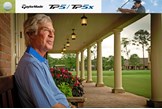 Ben Crenshaw won the Masters in 1984 and 1995.
Ben Crenshaw won the Masters in 1984 and 1995.
-
 The caddies believe The Masters is the easiest of the four Majors to win.
The caddies believe The Masters is the easiest of the four Majors to win.
-
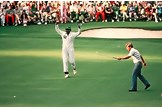 Ben Crenshaw holes a putt at the 1984 Masters.
Ben Crenshaw holes a putt at the 1984 Masters.
-
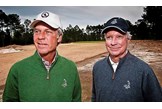 Bill Crenshaw with golf course design partner Bill Coore.
Bill Crenshaw with golf course design partner Bill Coore.
-
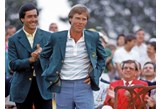 Ben Crenshaw slips on his first Green Jacket in 1984.
Ben Crenshaw slips on his first Green Jacket in 1984.
-
 Ben Crenshaw breaks down with Carl Jackson after winning the 1995 Masters.
Ben Crenshaw breaks down with Carl Jackson after winning the 1995 Masters.
-
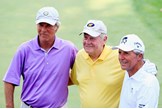 Crenshaw loves hearing the stories at the Masters' Champion's Dinner.
Crenshaw loves hearing the stories at the Masters' Champion's Dinner.
-
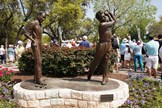 A statue of Harvey Penick and Tom Kite at Austin Country Club.
A statue of Harvey Penick and Tom Kite at Austin Country Club.
-
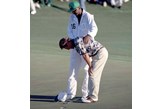 Ben Crenshaw breaks down with Carl Jackson after winning the 1995 Masters.
Ben Crenshaw breaks down with Carl Jackson after winning the 1995 Masters.
-
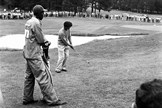 Ben Hogan playing the Masters.
Ben Hogan playing the Masters.
